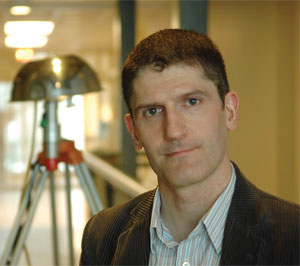 |
| As different products are invented and introduced to make our lives easier, more efficient and comfortable, they may be creating new, unforeseen problems, says Dr. Mark Gibson. (Danny Abriel Photo) |
Itâs estimated Canadians spend about 90 per cent of our time indoorsâand while weâd like to think the air we breathe inside is clean, thereâs no way of really knowing.
Until now, that is. HÂş»âs Atlantic RURAL Centreâs Environmental Health Laboratory is currently conducting a study in Halifax to determine what exactly weâre breathing in. The stuff we breathe indoors can be worse than outdoors for some pollutants, such as vaporized chemicals that come from paint and furniture, inhalable particles generated by heating and cooking appliances and biological particles, such as pet dander and moulds.
The $465,000 study has been commissioned by Health Canada and will form part of a national review of residential indoor air quality guidelines. The data from the Halifax study will be compared to previous studies conducted by health Canada in cities across the country, including Regina, Manitoba, Montreal, Quebec and Windsor, Ontario.
âWe expect to see different things from different parts of the country,â explains Judy Guernsey, director of Atlantic RURAL Centre. âRegina is in a very dry area, compared to Halifax. We expect to see more mould here because of the wet environment.
âIn Regina, moreover, more homes are heated with natural gas, whereas here we are reliant on oil for home heating. You can expect to see more carbon monoxide produced from inefficient heating systems. We will be monitoring the results to look for dangerous levels of carbon monoxide in participants homes.â
For the Halifax study, the centre is sampling 50 detached homes, some older and some brand new. Air quality testing is being done inside and outside the homes.
Mark Gibson, research scientist with The RURAL Centre, expects to find all kinds of nasty things in indoor air: âThere are combustion-related inhalable particles, a leaky furnace for example, cigarette smoke, pet dander, dust mites, dust mite feces, mould. Volatile organic compounds (VOCs) come from such things as personal care products and cleaning agents. Some VOCs, for example formaldehyde, off gas from various materials that include pressed-wood furniture, synthetic carpets, paint, adhesives, modern furnishings and draperies.
âSome are benign, some irritate the lungs and eyes, some are known to trigger or even cause asthma and some can cause cancer after many years of exposure,â says Dr. Gibson, an environmental health chemist, formerly a professor in Environmental Health at the University of Strathclyde, Scotland.
As different products are invented and introduced to make our lives easier, more efficient and comfortable, they may be creating new, unforeseen problems, says Dr. Gibson.
âYou look at some of our creations, such as certain pesticides, leaded gasoline, CFCs and asbestos to name a few examples, and you would have thought, these are going to make our lives better but came back to haunt us,â he says. âWe have to ask ourselves, what are the side effects?â
The Atlantic RURAL Centre opened its new Environmental Health Laboratory, the first of its kind in Atlantic Canada, late last year. The lab greatly expands our capacity to examine questions about the physical environment in relation to human health, says Dr. Guernsey, and the air quality study is a good example.
âBefore now, it has been profoundly difficult to understand the intricacies of these exposures and how they influence human health,â says Dr. Guernsey, professor with the Department of Community Health and Epidemiology in the Faculty of Medicine. âThe instrumentation and expertise associated with this lab enables us to undertake research studies that assess, very closely, aspects of the physical environment like air quality or contaminants in our food, soil and water and how they influence health. The data we collect may then be used by the public and by our regional and national government partners to make well informed decisions based upon local data.â
